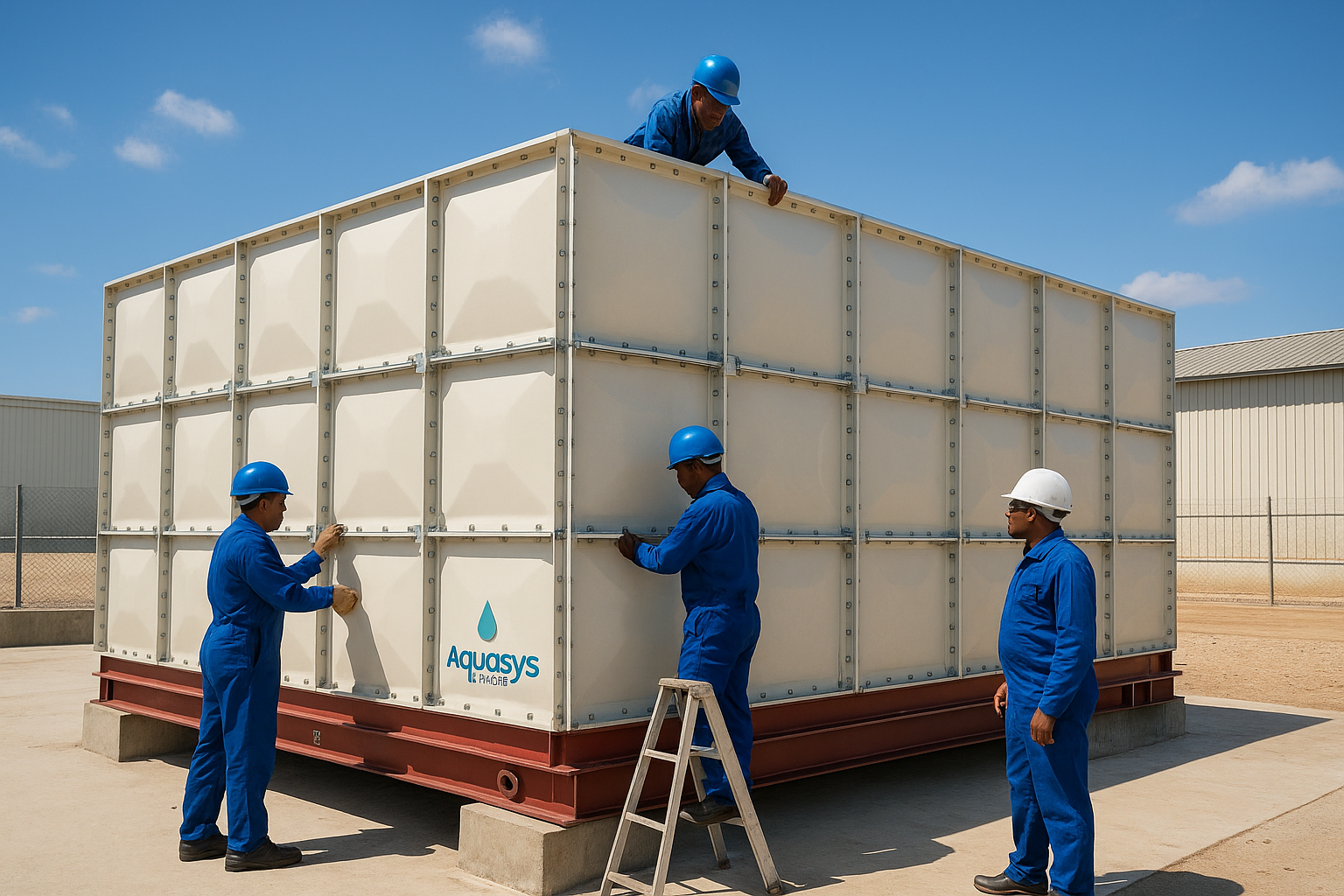GRP Water Tank Installation in Kenya

GRP Water Tank Installation in Kenya: Step-by-Step Guide, Cost & Expert Insights
Introduction: Why Professional GRP Water Tank Installation Matters
Whether you’re setting up a municipal reservoir, a high-rise water storage system, or an industrial process tank, the quality of installation determines how well your GRP (Glass Reinforced Plastic) water tank performs over its lifetime. In Kenya’s rapidly growing infrastructure landscape, many projects now prefer GRP due to its durability, hygiene, and modular design. However, even the best GRP panels can fail if not installed correctly — leading to leaks, deformation, or contamination.
This guide by Aquosys Limited — Kenya’s trusted manufacturer and installer of GRP sectional water tanks — explains the installation process, site preparation, costs, maintenance, and why professional expertise is essential for long-term success. Whether your project is residential, commercial, or industrial, our goal is to help you achieve a leak-free, high-performing GRP tank system.
Learn more about our company’s expertise on the About Us page.
Understanding GRP Water Tank Installation
GRP tank installation involves assembling sectional fiberglass-reinforced panels into a watertight structure, supported by a foundation or frame. The modular design allows on-site construction without heavy lifting machinery. This flexibility makes GRP ideal for urban rooftops, basement spaces, and remote rural projects where access is limited.
Installation components include:
- GRP panels (base, walls, roof)
- Bolts, nuts, washers, and gaskets
- Steel reinforcement frame or base supports
- Internal tie rods and bracing system
- Manhole, ladders, and fittings
Each project is unique. Aquosys Limited provides detailed engineering drawings, site supervision, and certified technicians for each Installation to ensure structural integrity and compliance with international standards.
Step 1: Site Preparation and Foundation Work
Proper site preparation ensures that the tank’s weight is evenly distributed and that long-term stability is maintained. Aquosys recommends that every GRP tank installation begins with a level concrete base or reinforced plinth.
Key site preparation steps:
- Survey and measurement: Verify the available footprint, height clearance, and access routes for panels.
- Foundation construction: Build a smooth, level base — typically 150–200 mm thick reinforced concrete — to support the tank’s load when full.
- Drainage planning: Provide proper drainage around the tank to prevent standing water and foundation erosion.
- Base inspection: The Aquosys technical team inspects the base before installation to confirm compliance with design specifications.
See GRP tank base specifications on the Characteristics page.
Step 2: Panel Assembly and Sealing
Once the base is ready, the sectional GRP panels are assembled. Each panel is aligned, bolted, and sealed with neoprene gaskets to form watertight joints.
Assembly sequence:
- Base panels are placed first and leveled precisely.
- Side wall panels are added and fastened using stainless steel bolts.
- Internal tie rods and supports are installed to prevent bowing under pressure.
- Roof panels and access manholes are fitted last.
The process demands skill and accuracy. Aquosys technicians follow precise torque specifications for each bolt to maintain seal compression without over-tightening.
To understand the panel structure and material properties, visit the GRP Panels page.
Step 3: Hydrostatic Testing and Quality Assurance
After assembly, a hydrostatic test is performed — the tank is filled gradually with water and observed for 24–48 hours. Any leaks, distortions, or fitting issues are corrected immediately.
Hydrostatic test objectives:
- Check for watertight seals and bolt tightness
- Confirm structural alignment under pressure
- Verify outlet/inlet fitting performance
- Ensure no panel deflection beyond tolerance limits
Only after successful testing does the tank get commissioned for use. Aquosys provides a full installation and testing certificate for client records.
Step 4: Safety Precautions During Installation
Safety is paramount during GRP tank assembly. Aquosys follows strict safety protocols to protect personnel and ensure structural compliance.
- Use of personal protective equipment (PPE)
- Restricted access zones during panel lifting
- Proper torque-controlled tools
- Inspection of ladders, scaffolding, and rigging gear
- Trained supervision for elevated installations
Detailed site safety measures are outlined on our Caution page.
Step 5: Maintenance and After-Installation Care
Routine maintenance ensures that the tank continues to perform efficiently. GRP tanks are low-maintenance compared to steel or concrete systems, but they still benefit from scheduled inspections.
Maintenance checklist:
- Quarterly visual inspections for leaks or cracks
- Annual cleaning to remove sediment or scale
- Periodic bolt torque re-check
- Inspection of gaskets and seal integrity
Aquosys offers maintenance contracts and refurbishment services. Learn more about professional upkeep on the Installation page.
Cost of GRP Tank Installation in Kenya
Installation costs vary depending on capacity, site conditions, accessibility, and required fittings. For a medium-sized sectional GRP tank (100,000–250,000 litres), installation costs typically range between KES 150,000 to 500,000+, excluding civil works.
Factors affecting cost:
- Tank size and design complexity
- Distance to site and logistics
- Foundation preparation requirements
- Accessories such as manholes, ladders, and level gauges
- On-site supervision and testing needs
Get an accurate quotation customized to your project through our Get in Touch page.
Why Choose Aquosys Limited for GRP Tank Installation
Aquosys Limited is a proven partner for large-scale and customized GRP water tank installations across Kenya and East Africa. With in-house design engineers and skilled technicians, the company guarantees quality workmanship and long-term reliability.
- Certified GRP panel manufacturing and testing
- Experienced project teams
- End-to-end installation and commissioning
- Post-installation maintenance support
Explore completed installations in our Portfolio and Gallery.
Ready to Install a GRP Water Tank in Kenya?
Let the experts at Aquosys Limited handle your next GRP tank project — from design to installation and maintenance.
COUNTRYWIDE PROJECT SUPPORT AVAILABLE
✔ Expert installation & engineering support
✔ Large-scale & custom designs available
✔ Serving Kenya, Uganda, Tanzania, Rwanda, South Sudan, Ethiopia & beyond
📞 Contact Us
Aquosys Limited
📧 sales@aquosys.co.ke
📞 +254 754 750 750 | +254 729 749 749
🌐 Get in Touch


